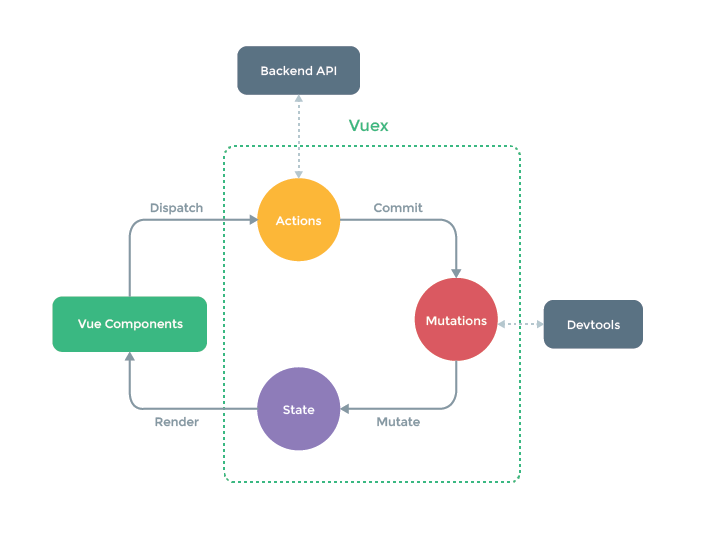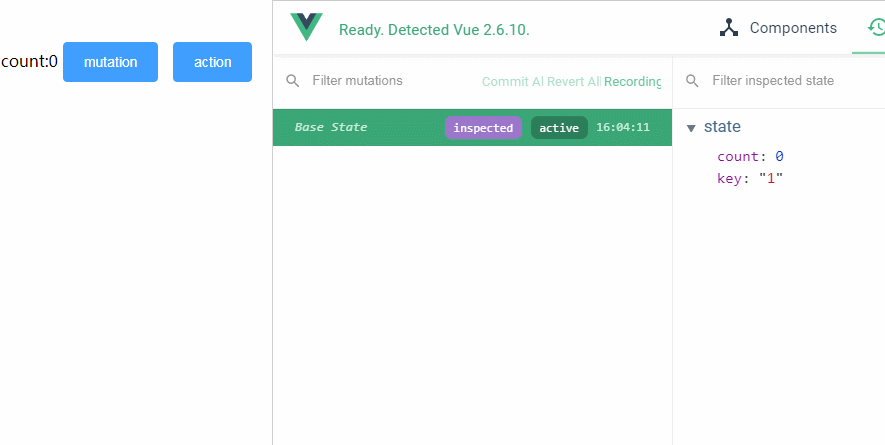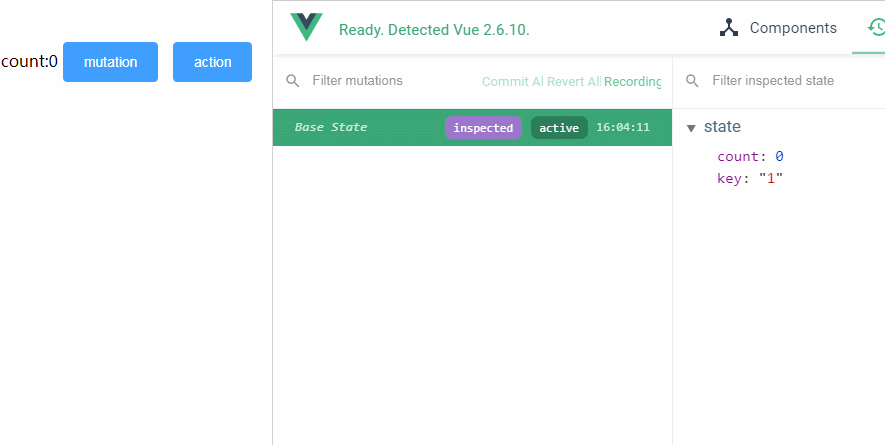# 5. vuex使用总结

# 1. 使用vuex
1、数据从state中渲染到页面; 2、在页面通过dispatch来触发action; 3、action通过调用commit,来触发mutation; 4、mutation来更改数据,数据变更之后会触发dep对象的notify,通知所有Watcher对象去修改对应视图(vue的双向数据绑定原理)。
//main.js
import store from './store.js';
new Vue({
// 把 store 对象提供给 “store” 选项,这可以把 store 的实例注入所有的子组件
store,
...App
}).$mount('#app')
//store.js
import Vue from 'Vue'
import Vuex from 'Vuex'
Vue.use(Vuex);
export default new Vuex.Store({
state: {
count: '1'
},
getters: {
getcount: (state,getters) => {
return state.count
}
},
mutations: {
increment (state, payload) {
state.count= payload;
}
},
actions: {
incrementAsync(context) {
context.commit('increment ')
}
}
});
//组件中watch监听
watch: {
'$store.state.key':function(newval,oldval){
console.log(newval,oldval)
}
},
2
3
4
5
6
7
8
9
10
11
12
13
14
15
16
17
18
19
20
21
22
23
24
25
26
27
28
29
30
31
32
33
34
35
36
37
38
39
40
41
# 2. State
//store.js
state: {
count: '1'
},
//使用
// 在单独构建的版本中辅助函数为 Vuex.mapState
// mapState 函数返回的是一个对象
import { mapState } from 'vuex'
export default {
// ...
methods:{
s(){return this.$store.state.count;}
},
computed: mapState({
// 箭头函数可使代码更简练
count: state => state.count,
// 传字符串参数 'count' 等同于 `state => state.count`
countAlias: 'count',
// 映射 this.count 为 store.state.count
'count'
// 为了能够使用 `this` 获取局部状态,必须使用常规函数
countPlusLocalState (state) {
return state.count + this.localCount
}
})
computed: mapState(['count'])
computed:{
localComputed () { /* ... */ },
// 使用对象展开运算符将此对象混入到外部对象中
...mapState({
count
})//等同于count(){return this.$store.state.count;}
}
}
2
3
4
5
6
7
8
9
10
11
12
13
14
15
16
17
18
19
20
21
22
23
24
25
26
27
28
29
30
31
32
33
34
35
36
37
38
39
40
41
# 3. Getters
可以认为是 store 的计算属性。就像计算属性一样,getter 的返回值会根据它的依赖被缓存起来,且只有当它的依赖值发生了改变才会被重新计算。
//store.js
getters: {
getcount: (state,getters) => {
return state.count
}
}
//使用
import { mapState } from 'vuex'
export default {
// ...
methods:{
s(){return this.$store.getters.getcount;}
},
computed: {
// 使用对象展开运算符将 getter 混入 computed 对象中
...mapGetters([
'doneTodosCount',
'anotherGetter',
// ...
])
mapGetters({
// 把 `this.doneCount` 映射为 `this.$store.getters.doneTodosCount`
doneCount: 'doneTodosCount'
})
}
}
2
3
4
5
6
7
8
9
10
11
12
13
14
15
16
17
18
19
20
21
22
23
24
25
26
27
28
29
30
# 4. mutation
Mutation 必须是同步函数
//store.js
mutations: {
increment (state, n) {
state.count += n
},
// 我们可以使用 ES2015 风格的计算属性命名功能来使用一个常量作为函数名
[SOME_MUTATION] (state) {
// mutate state
}
}
//使用
import { mapMutations } from 'vuex'
export default {
// ...
methods:{
test(){
this.$store.commit('increment', 10)
this.$store.commit({
type: 'increment',
amount: 10
})
},
...mapMutations([
'increment', // 将 `this.increment()` 映射为 `this.$store.commit('increment')`
// `mapMutations` 也支持载荷:
'incrementBy' // 将 `this.incrementBy(amount)` 映射为 `this.$store.commit('incrementBy', amount)`
]),
...mapMutations({
add: 'increment' // 将 `this.add()` 映射为 `this.$store.commit('increment')`
})
}
}
2
3
4
5
6
7
8
9
10
11
12
13
14
15
16
17
18
19
20
21
22
23
24
25
26
27
28
29
30
31
32
33
34
35
# 5. Action
Action 类似于 mutation,不同在于:
- Action 提交的是 mutation,而不是直接变更状态。
- Action 可以包含任意异步操作。
Action 函数接受一个与 store 实例具有相同方法和属性的 context 对象,因此你可以调用 context.commit 提交一个 mutation,或者通过 context.state 和 context.getters 来获取 state 和 getters
//store.js
actions: {
incrementAsync({ commit }) {//解构context
commit('increment')
}
//执行actionB会先执行actionA,返回一个Promise,resolve成功后执行commit
actionB ({ dispatch, commit }) {
return dispatch('actionA').then(() => {
commit('someOtherMutation')
})
}
// 假设 getData() 和 getOtherData() 返回的是 Promise
async actionA ({ commit }) {
commit('gotData', await getData())
},
async actionB ({ dispatch, commit }) {
await dispatch('actionA') // 等待 actionA 完成
commit('gotOtherData', await getOtherData())
}
}
//使用
import { mapActions } from 'vuex'
export default {
// ...
methods:{
test(){
this.$store.dispatch('incrementAsync')
// 以对象形式分发
this.$store.dispatch({
type: 'incrementAsync',
amount: 10
})
},
...mapActions([
'incrementAsync', // 将 `this.incrementAsync()` 映射为 `this.$store.dispatch('incrementAsync')`
// `mapActions` 也支持载荷:
'incrementBy' // 将 `this.incrementBy(amount)` 映射为 `this.$store.dispatch('incrementBy', amount)`
]),
...mapActions({
add: 'incrementAsync' // 将 `this.add()` 映射为 `this.$store.dispatch('incrementAsync')`
})
}
}
2
3
4
5
6
7
8
9
10
11
12
13
14
15
16
17
18
19
20
21
22
23
24
25
26
27
28
29
30
31
32
33
34
35
36
37
38
39
40
41
42
43
44
45
46
47
# 6. Mutation与Action差异
Muation与Action作用是相同的,官网上说Mutation 必须是同步函数,Action处理异步函数。我觉得这是因为在vue devtool调试工具状态管理中,如果Mutation是异步函数,mutation 触发的时候,回调函数还没有被调用,devtools 不知道什么时候回调函数实际上被调用就会导致devtool中状态管理不可追踪,这个问题就会导致调试非常难。而在action中的异步函数中提交mutation是可以追踪状态的。 总的来说,使用devtool调试,异步函数在muation中状态是不可追踪的,在action中状态是可以追踪的。如果你不使用devtool两者其实就是一样的,只不过mutation函数第一个参数是state,action 函数接受一个与 store 实例具有相同方法和属性的 context 对象。 例子:
//store.js
state: {
key: '1',
count:0
},
mutations: {
updateCount(state, payload) {
setTimeout(() => {
state.count += 1;
}, 2000);
},
xupdateCount(state, payload) {
setTimeout(() => {
state.count += 1;
}, 2000);
}
},
actions: {
asyncUpdateCount(context, payload) {
setTimeout(() => {
// context.state.count += 1;//这种是可以的,页面会响应。但是在vue devtool状态管理中监听不到变化,就会导致调试困难。
context.commit('xupdateCount')
}, 2000);
}
}
//组件中
count:{{count}}
<el-button type="primary" @click="setkey">mutation</el-button>
<el-button type="primary" @click="setkey2">action</el-button>
computed: {
count(){
return this.$store.state.count
}
},
methods: {
setkey(){
this.$store.commit('updateCount')
},
setkey2(){
this.$store.dispatch('asyncUpdateCount')
}
},
2
3
4
5
6
7
8
9
10
11
12
13
14
15
16
17
18
19
20
21
22
23
24
25
26
27
28
29
30
31
32
33
34
35
36
37
38
39
40
41
42
43
44
点击mutation,devtool中会立即记录状态,但这个状态并不是异步执行时的状态。效果如下:
 点击action按钮,devtool中会记录异步执行时的状态。效果如下:
点击action按钮,devtool中会记录异步执行时的状态。效果如下:

# 7. Module
Vuex 允许我们将 store 分割成模块(module)。每个模块拥有自己的 state、mutation、action、getter、甚至是嵌套子模块
const moduleA = {
state: { ... },
mutations: { ... },
actions: { ... },
getters: { ... }
}
const moduleB = {
state: { ... },
mutations: { ... },
actions: { ... }
}
const store = new Vuex.Store({
modules: {
a: moduleA,
b: moduleB
}
})
store.state.a // -> moduleA 的状态
store.state.b // -> moduleB 的状态
2
3
4
5
6
7
8
9
10
11
12
13
14
15
16
17
18
19
20
21
22
对于模块内部的 mutation 和 getter,接收的第一个参数是模块的局部状态对象。 同样,对于模块内部的 action,局部状态通过 context.state 暴露出来,根节点状态则为 context.rootState
//moduleA
const moduleA = {
state: { count: 0 },
mutations: {
increment (state) {
// 这里的 `state` 对象是模块的局部状态
}
},
getters: {//对于模块内部的 getter,根节点状态会作为第三个参数rootState暴露出来
doubleCount (state, getters, rootState) {
}
}
}
2
3
4
5
6
7
8
9
10
11
12
13
命名空间
默认情况下,模块内部的 action、mutation 和 getter 是注册在全局命名空间的——这样使得多个模块能够对同一 mutation 或 action 作出响应。
如果希望你的模块具有更高的封装度和复用性,你可以通过添加 namespaced: true 的方式使其成为带命名空间的模块。当模块被注册后,它的所有 getter、action 及 mutation 都会自动根据模块注册的路径调整命名。启用了命名空间的 getter 和 action 会收到局部化的 getter,dispatch 和 commit。
const store = new Vuex.Store({
modules: {
account: {
namespaced: true,
// 模块内容(module assets)
state: { ... }, // 模块内的状态已经是嵌套的了,使用 `namespaced` 属性不会对其产生影响
getters: {
isAdmin () { ... } // -> getters['account/isAdmin']
},
actions: {
login () { ... } // -> dispatch('account/login')
},
mutations: {
login () { ... } // -> commit('account/login')
},
// 嵌套模块
modules: {
// 继承父模块的命名空间
myPage: {
state: { ... },
getters: {
profile () { ... } // -> getters['account/profile']
}
},
// 进一步嵌套命名空间
posts: {
namespaced: true,
state: { ... },
getters: {
popular () { ... } // -> getters['account/posts/popular']
}
}
}
}
}
})
2
3
4
5
6
7
8
9
10
11
12
13
14
15
16
17
18
19
20
21
22
23
24
25
26
27
28
29
30
31
32
33
34
35
36
37
38
39
40
在带命名空间的模块内访问全局内容(Global Assets)
如果你希望使用全局 state 和 getter,rootState 和 rootGetter 会作为第三和第四参数传入 getter,也会通过 context 对象的属性传入 action。
若需要在全局命名空间内分发 action 或提交 mutation,将 { root: true } 作为第三参数传给 dispatch 或 commit 即可。
modules: {
foo: {
namespaced: true,
getters: {
// 在这个模块的 getter 中,`getters` 被局部化了
// 你可以使用 getter 的第四个参数来调用 `rootGetters`
someGetter (state, getters, rootState, rootGetters) {
getters.someOtherGetter // -> 'foo/someOtherGetter'
rootGetters.someOtherGetter // -> 'someOtherGetter'
},
someOtherGetter: state => { ... }
},
actions: {
// 在这个模块中, dispatch 和 commit 也被局部化了
// 他们可以接受 `root` 属性以访问根 dispatch 或 commit
someAction ({ dispatch, commit, getters, rootGetters }) {
getters.someGetter // -> 'foo/someGetter'
rootGetters.someGetter // -> 'someGetter'
dispatch('someOtherAction') // -> 'foo/someOtherAction'
dispatch('someOtherAction', null, { root: true }) // -> 'someOtherAction'
commit('someMutation') // -> 'foo/someMutation'
commit('someMutation', null, { root: true }) // -> 'someMutation'
},
someAction: {
root: true,
handler (namespacedContext, payload) { ... } // -> 'someAction'
}
someOtherAction (ctx, payload) { ... }
}
}
}
2
3
4
5
6
7
8
9
10
11
12
13
14
15
16
17
18
19
20
21
22
23
24
25
26
27
28
29
30
31
32
33
34
35
36
module中的辅助函数
computed: {
...mapState({
a: state => state.some.nested.module.a,
b: state => state.some.nested.module.b
})
...mapState('some/nested/module', {
a: state => state.a,
b: state => state.b
})
},
methods: {
...mapActions([
'some/nested/module/foo', // -> this['some/nested/module/foo']()
'some/nested/module/bar' // -> this['some/nested/module/bar']()
])
...mapActions('some/nested/module', [
'foo', // -> this.foo()
'bar' // -> this.bar()
])
}
2
3
4
5
6
7
8
9
10
11
12
13
14
15
16
17
18
19
20
21
22
import { createNamespacedHelpers } from 'vuex'
const { mapState, mapActions } = createNamespacedHelpers('some/nested/module')
export default {
computed: {
// 在 `some/nested/module` 中查找
...mapState({
a: state => state.a,
b: state => state.b
})
},
methods: {
// 在 `some/nested/module` 中查找
...mapActions([
'foo',
'bar'
])
}
}
2
3
4
5
6
7
8
9
10
11
12
13
14
15
16
17
18
19
20
严格模式
在严格模式下,无论何时发生了状态变更且不是由 mutation 函数引起的,将会抛出错误。这能保证所有的状态变更都能被调试工具跟踪到。
const store = new Vuex.Store({
// ...
strict: true
})
2
3
4